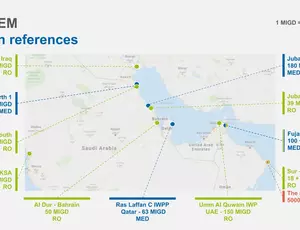DESALINATION BY DISTILLATION
Distillation means evaporation and condensation of a fluid. The resulting condensed product is free from salt. This basic principle, as natural as rain, is widely used in sea-water desalination.
The two main sea water distillation processes are called multi-stage flashing (MSF) and multi-effect desalination (MED). Depending on the availability of energy on-site, and its quality, MED plants may be fitted with a compressor (thermal or mechanical) in order to enhance their performance and to optimise energy requirements. The processes are then called MED-TVC (thermal vapour compression) and MED-MVC (mechanical vapour compression).
Most of the time, and in particular for large plants, the lowest cost is obtained by coupling power and water production, the exhaust conditions of the turbines being optimized to feed the desalination units. The large desalination plants of the Arabian Sea are usually developed on such concept, called cogeneration. Sometimes reverse osmosis is associated to the thermal desalination process to optimise the Power Plant turbines: the hybrid plant.
Multiple Effect Distillation
The most efficient, economical and easy-to-operate thermal desalination process
MED
Multiple-effect distillation (MED) is the low temperature thermal process of obtaining fresh water by recovering the vapour of boiling sea water in a sequence of vessels, (called effects) each maintained at a lower temperature than the last. Because the boiling point of water decreases as pressure decreases, the vapour boiled off in one vessel can be used to heat the next one, and only the first one (at the highest pressure) requires an external source of heat.
WATER BOILING POINT TABLE
|
|
|
|
|
|
|
|
|
|
|
|
|
|
By maintaining the effects at low pressure the sea water remains at temperatures below 65°C, thus avoiding unnecessary heating and allowing a good control of scaling.
Multiple Effect Distillation Process
The heart of the process: the MED evaporator
Multiple Effect Distillation Process
The MED evaporator consists of several consecutive cells maintained at a decreasing level of pressure (and temperature) from the first (hot) to the last (cold). Each cell (also called effect) contains a horizontal tube bundle. The top of the bundle is sprayed with sea water make-up that flows down from tube to tube by gravity. Heating steam is introduced inside the tubes. Since tubes are cooled externally by make-up flow, steam condenses into distillate (fresh water) inside the tubes. The heat released by the condensation (latent heat)warms up the sea-water outside the tubes and partly evaporates it. Due to evaporation, sea water slightly concentrates when flowing down the bundle and gives brine at the bottom of the cell. The vapour raised by sea-water evaporation is at a lower temperature than heating steam. However it can still be used as a heating medium for the next effect where the process repeats. In the last cell, the produced steam condenses in a conventional shell and tubes heat exchanger. This exchanger, called "distillate condenser" or "final condenser" is cooled by sea-water. At the outlet of the final condenser, part of the warmed sea-water is used as make-up of the unit, the other part is rejected to the sea.
Brine and distillate are collected from cell to cell till the last one, where from they are extracted by centrifugal pumps.
The heating steam of the first effect is generally low pressure condensing steam (as low as 0.3 bar abs). Other heating media (such as hot water) may be used.
Multiple Effect Distillation Process
Multiple Effect Distillation
The most efficient, economical and easy-to-operate thermal desalination process
MED
Multiple-effect distillation (MED) is the low temperature thermal process of obtaining fresh water by recovering the vapour of boiling sea water in a sequence of vessels, (called effects) each maintained at a lower temperature than the last. Because the boiling point of water decreases as pressure decreases, the vapour boiled off in one vessel can be used to heat the next one, and only the first one (at the highest pressure) requires an external source of heat.
WATER BOILING POINT TABLE
| PRESSURE | 1BAR | 0.47 BAR | 0.32 BAR (TOP OF EVEREST) | 0.25 BAR | 0.1 BAR |
|---|---|---|---|---|---|
| BOILING POINT | 100°C | 80°C | 70°C | 65°C | 45°C |
By maintaining the effects at low pressure the sea water remains at temperatures below 65°C, thus avoiding unnecessary heating and allowing a good control of scaling.
- See the "MED Process Description" page for further details.



